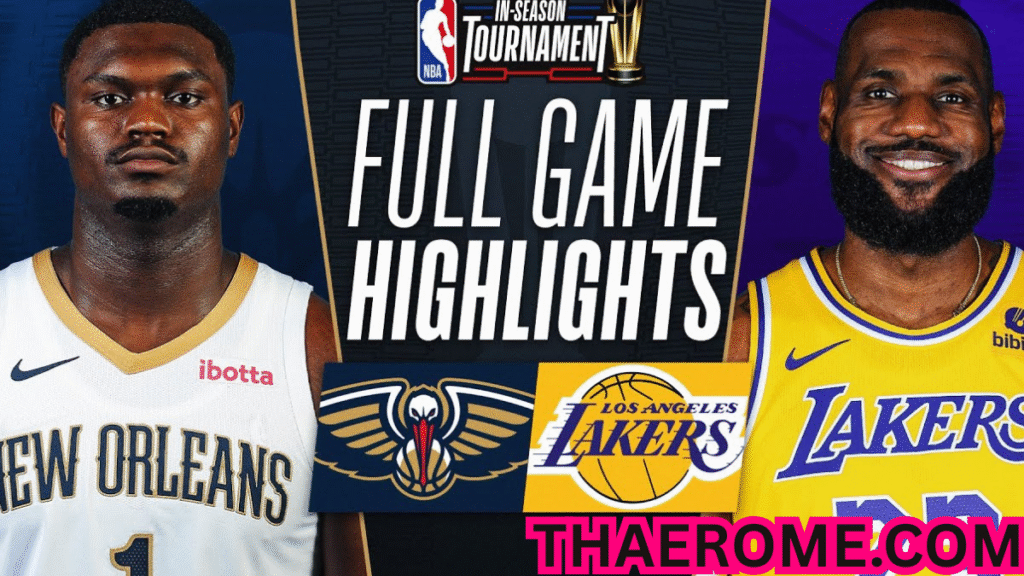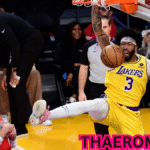Introduction to the Riveting Matchup
New Orleans Pelicans vs Lakers Match Player Stats The clash between the New Orleans Pelicans and the Los Angeles Lakers always delivers compelling basketball action. Both franchises are part of the Western Conference in the NBA and have distinct histories and ambitions. While the Lakers carry a legacy filled with championships and star-studded rosters, the Pelicans represent a younger team with rising talent and the hunger to carve out their own identity in the league. When these two teams meet, the court becomes a battlefield showcasing a mix of experience and youth, physicality and finesse, and superstar brilliance on both sides.
Game Overview and Momentum Shifts
The recent encounter between the New Orleans Pelicans and the Los Angeles Lakers drew significant attention due to the narrative surrounding each team’s season trajectory. The game began with a high tempo, as both sides aimed to control the pace early. The Pelicans emphasized transition play and ball movement while the Lakers leaned on their veteran stars for stability. The first quarter saw an exchange of leads, but the Lakers edged ahead through efficient shooting and strong rebounding.
As the second quarter unfolded, the Pelicans began to find their rhythm. Their young core brought energy and versatility, countering the Lakers’ structured offense. With a series of fast breaks and mid-range shots, the Pelicans narrowed the deficit. However, New Orleans Pelicans vs Lakers Match Player Stats a late surge led by LeBron James gave the Lakers a slight advantage at halftime. The intensity of the match continued through the second half, with both teams trading baskets in a tightly contested showdown.
LeBron James’ Performance and Leadership
LeBron James, the cornerstone of the Lakers, delivered a masterclass performance that underscored his importance to the team. He registered over 30 points, combining outside shooting with his trademark drives to the basket. In addition to his scoring, LeBron displayed exceptional playmaking ability, contributing over 10 assists, facilitating ball movement, and making key passes during crucial stretches.
His presence on defense was equally vital. LeBron executed critical switches and managed to defend multiple positions, illustrating his two-way impact. Beyond the numbers, his leadership was evident as he guided younger teammates, called plays on the court, and provided emotional stability during high-pressure moments.
Anthony Davis’ Dominance in the Paint
Anthony Davis was another standout performer for the Lakers. Facing his former team, he seemed determined to leave an impact. Davis recorded a double-double, grabbing more than 12 rebounds while scoring prolifically inside the paint. His presence disrupted the Pelicans’ offense, as his shot-blocking altered several attempts near the rim.
Offensively, Davis was effective both as a roll man in pick-and-roll situations and as a post-up threat. He exploited mismatches and drew multiple defenders, which opened up opportunities for the Lakers’ shooters on the perimeter. His ability to affect both ends of the floor made him one of the decisive factors in the match.
Zion Williamson’s Explosiveness and Scoring Prowess
Zion Williamson, the rising star of the New Orleans Pelicans, had a remarkable outing against the Lakers. Displaying his unique blend of power and agility, Zion scored over 25 points while shooting with high efficiency. His quick first step and brute strength allowed him to get past defenders and finish at the rim with authority.
Zion was relentless on the offensive glass and contributed multiple second-chance points. His ability to push the ball in transition and drive through contact kept the Lakers on their heels. Though he faced challenges from Davis’ defense, Zion remained aggressive and provided his team with a constant scoring option.
Brandon Ingram’s All-Around Contribution
Former Lakers forward Brandon Ingram had an emotionally charged performance against his old team. He scored around 20 points and made a notable impact with his mid-range game. Ingram’s shooting mechanics and footwork allowed him to create separation and hit contested shots. He also contributed as a secondary playmaker, with several assists stemming from his ability to attract defenders and make timely passes.
Defensively, Ingram showed resilience, taking on the task of guarding both perimeter and wing players. While his scoring cooled off in the second half, his overall influence remained substantial due to his versatility and calm presence.
CJ McCollum’s Shooting and Veteran Leadership
CJ McCollum served as a stabilizing force for the Pelicans. His ability to score in isolation and operate in pick-and-rolls gave the team an edge in moments when offensive flow waned. McCollum connected on several three-pointers and was instrumental in keeping the Pelicans within striking distance. He also logged close to 7 assists, proving his ability to function as both a scorer and distributor.
As one of the most experienced players on the roster, McCollum’s communication and floor awareness were invaluable. He orchestrated plays, calmed down teammates during tense moments, and ensured that the Pelicans maintained structure on both ends of the floor.
Bench Contributions and Role Players
Both teams saw significant input from their respective benches. For the Lakers, players like Austin Reaves and Rui Hachimura played pivotal roles. Reaves provided timely shooting and secondary ball-handling, while Hachimura added size and rebounding. Their hustle plays and effort on defense added depth to the Lakers’ performance.
On the Pelicans’ side, Jose Alvarado brought his signature intensity and defensive grit. Known for his on-ball pressure and ability to create turnovers, Alvarado disrupted the Lakers’ rhythm and injected energy into his team. Naji Marshall and Trey Murphy III also added valuable minutes with timely scoring and strong defensive coverage.
Team Stats and Tactical Observations
The overall team statistics revealed a closely contested battle. The Lakers shot marginally better from the field and capitalized on their free-throw opportunities. The Pelicans, however, held a slight edge in points in the paint and fast-break points, thanks to their youthful legs and pace.
Rebounding was nearly even, although offensive rebounds favored the Pelicans. Turnovers became a critical point of difference; the Pelicans committed more, leading to easy transition buckets for the Lakers. The Lakers’ ability to slow down the pace in key moments and execute in half-court sets proved decisive.
Defensively, the Lakers showed more consistency, with better rotations and closeouts on shooters. The Pelicans struggled with pick-and-roll coverages and allowed several open looks from beyond the arc. Despite that, their defensive intensity remained high, with multiple deflections and hustle plays throughout the game.
Coaching Strategies and Adjustments
Darvin Ham, the head coach of the Lakers, emphasized a structured offense and strong communication on defense. He utilized a shorter rotation in the second half, keeping his star players on the court for longer stretches. The Lakers focused on exploiting the Pelicans’ defensive lapses and made successful adjustments in how they defended Zion Williamson in the second half.
Willie Green, coaching the Pelicans, employed a fast-paced strategy early on and encouraged ball-sharing. His halftime adjustments included doubling LeBron on isolation plays and increasing off-ball movement on offense. Though some of these tactics paid off, defensive breakdowns and inconsistency in execution hampered their ability to sustain momentum.
Conclusion: A Contest Defined by Star Power and Execution
The showdown between the New Orleans Pelicans and the Los Angeles Lakers showcased the high caliber of basketball that defines the NBA. With star players like LeBron James, Anthony Davis, Zion Williamson, and Brandon Ingram putting on a show, fans witnessed a mixture of brilliance, strategy, and determination.
The Lakers’ experience, balanced roster, and defensive focus ultimately helped them edge out the Pelicans. However, the Pelicans’ youthful energy, depth, and potential were evident and suggest a bright future ahead. This game served as a reminder of the intense competition in the Western Conference and how each matchup can shape playoff seeding and long-term momentum.
FAQs
Who was the top scorer in the Pelicans vs Lakers match?
LeBron James led the scoring with over 30 points, showcasing his ability to dominate in high-pressure situations.
How did Anthony Davis perform against the Pelicans?
Anthony Davis had a standout game, securing a double-double with points and rebounds, and was dominant in the paint on both ends of the floor.
What were Zion Williamson’s key contributions?
Zion contributed significantly with his explosive scoring, efficient shooting, and offensive rebounding, keeping the Pelicans competitive throughout the match.
Which player stood out from the Pelicans bench?
Jose Alvarado stood out with his defensive intensity, creating turnovers and providing energy that shifted momentum at crucial points.
How did team stats compare between the Lakers and Pelicans?
The Lakers had better shooting percentages and fewer turnovers, while the Pelicans had more fast-break points and offensive rebounds.
Was this game important for playoff standings?
Yes, given the tight race in the Western Conference, every win is crucial. This matchup had significant implications for playoff seeding and team morale.
Who coached the teams during the match?
Darvin Ham coached the Lakers, and Willie Green coached the Pelicans, both bringing different strategies and leadership styles to the game.
What were some tactical decisions that influenced the outcome?
The Lakers’ decision to double Zion in the second half and New Orleans Pelicans vs Lakers Match Player Stats exploit defensive mismatches through pick-and-roll plays were critical to their success.
Did Brandon Ingram have an impact playing against his former team?
Yes, Ingram delivered a well-rounded performance with scoring and playmaking, though he was unable to lift his team to victory.
What’s next for both teams after this match?
The Lakers look to build momentum for playoff contention, while the Pelicans continue to develop their young core and aim for consistency in upcoming games.


